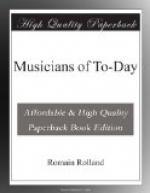His orchestra is not less composite. It is not a compact and serried mass like Wagner’s Macedonian phalanxes; it is parcelled out and as divided as possible. Each part aims at independence and works as it thinks best, without apparently troubling about the other parts. Sometimes it seems, as it did when reading Berlioz, that the execution must result in incoherence, and weaken the effect. But somehow the result is very satisfying. “Now doesn’t that sound well?” said Strauss to me with a smile, just after he had finished conducting Heldenleben.[180]
[Footnote 180: The composition of the orchestra in Strauss’s later works is as follows: In Zarathustra: one piccolo, three flutes, three oboes, one English horn, one clarinet in E flat, two clarinets in B, one bass-clarinet in B, three bassoons, one double-bassoon, six horns in F, four trumpets in C, three trombones, three bass-tuba, kettledrums, big drum, cymbals, triangle, chime of bells, bell in E, organ, two harps, and strings. In Heldenleben: eight horns instead of six, five trumpets instead of four (two in E flat, three in B); and, in addition, military drums.]
But it is especially in Strauss’s subjects that caprice and a disordered imagination, the enemy of all reason, seem to reign. We have seen that these poems try to express in turn, or even simultaneously, literary texts, pictures, anecdotes, philosophical ideas, and the personal sentiments of the composer. What unity is there in the adventures of Don Quixote or Till Eulenspiegel? And yet unity is there, not in the subjects, but in the mind that deals with them. And these descriptive symphonies with their very diffuse literary life are vindicated by their musical life, which is much more logical and concentrated. The caprices of the poet are held in rein by the musician. The whimsical Till disports himself “after the old form of rondeau,” and the folly of Don Quixote is told in “ten variations on a chivalrous theme, with an introduction and finale.” In this way, Strauss’s art, one of the most literary and descriptive in existence, is strongly distinguished from others of the same kind by the solidarity of its musical fabric, in which one feels the true musician—a musician brought up on the great masters, and a classic in spite of everything.
And so throughout that music a strong unity is felt among the unruly and often incongruous elements. It is the reflection, so it seems to me, of the soul of the composer. Its unity is not a matter of what he feels, but a matter of what he wishes. His emotion is much less interesting to him than his will, and it is less intense, and often quite devoid of any personal character. His restlessness seems to come from Schumann, his religious feeling from Mendelssohn, his voluptuousness from Gounod or the Italian masters, his passion from Wagner.[181] But his will is heroic, dominating, eager, and powerful to a sublime degree. And that is why Richard Strauss is noble and, at present, quite unique. One feels in him a force that has dominion over men.




